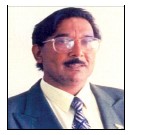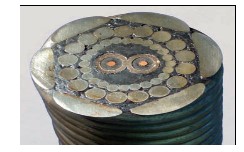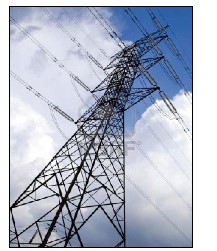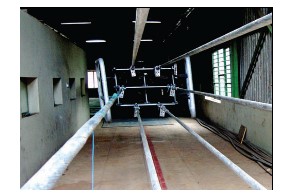
—
D.C. Galada, President, Cable & Conductor
Manufacturers' Association of India (CACMAI)
CACMAI, India's premier organisation catering to the cables
and conductor industry, has been serving the power sector
for nearly four decades. It has taken up critical industry
issues with the government and is largely responsible for
the growth of the cables and conductors industry in India. In
this exclusive interaction,
D.C. Galada talks at length about
various issues and concerns affecting the cables and
conductor industry, and suggests concrete remedial
measures. An interview by
Venugopal Pillai.
To begin with, please tell us about CACMAI in terms of its incorporation and major activities.
Cable & Conductor Manufacturers Association of India (CACMAI) was registered in 1973
and started its activities in 1974. It celebrated its "Silver Jubilee Year" in 1998. CACMAI has
taken up the cause of its members very vigorously during its 37 years of existence, and has
made valuable contribution to power sector during last seven Five-Year Plans.
It has worked hand in hand with the Government of India and several government bodies
to introduce new products like AAAC, ABC etc and its has worked with BIS to standardize
inputs and different types of conductors for transmission, distribution and rural
electrification application.
CACMAI has worked closely with the ministry of steel & mines and primary producers of
aluminium to streamline supply of "EC & Alloy Aluminium" in ingot and wire rod form to the
conductor industry, and secondary Rod Rolling Plants.
Now as a mature non-government, not-for-profit, industry-led and industry-managed
organisation, CACMAI proposes to play a more proactive role in member industries'
development programme.
CACMAI believes that conductors are the most vital inputs in transmission, distribution
and rural electrification programmes of the Union power ministry to make electricity
available to every citizen of India by 2012. It wants to work hand in hand with the government
to construct all types of transmission & distribution lines, which are most efficient, safe and
long lasting. It wants to participate actively in containing the T&D losses below 8-10 per cent
through innovations in line design and choice of right conductors (size and type) during the
XI and XII Plan periods, and even thereafter.
CACMAI has successfully conducted several international symposiums/national
seminars/workshops and meets to enhance awareness on different types of conductors;
quality of main raw material namely aluminium; and to highlight the role of conductors
efficient transmission, distribution and rural electrification.
 How has the growth in membership been in recent years? What is the
geographical distribution of CACMAI members?
How has the growth in membership been in recent years? What is the
geographical distribution of CACMAI members?
CACMAI membership during 2010-11 stands at 186. Major
manufactures have been members for years. CACMAI is divided into
five regions based on Government of India pattern, namely northern,
western, southern, eastern, and north-eastern. The region-wise
membership distribution is northern 54 per cent, western 17 per
cent, southern 14 per cent, eastern 14 per cent and north-eastern 1
per cent. The membership has been more or less steady during last
five years.
With major investments happening in the power sector, how do you
gauge the prospects of the cables and conductors industry in the
medium term?
Large investments have been planned in power sector during XI and
XII Plan periods, covering all aspects including generation,
transmission and distribution etc. CACMAI, as an apex body mainly of
conductor manufacturers, has projected a requirement of 25-30 lakh
tonnes and 30-35 lakh tonnes of overhead conductors, during the XI
and XII Plan periods, respectively. During the period 2011-2017,
CACMAI expects a demand of 35-41 lakh tonnes of overhead
conductors namely ACSR (Aluminium Conductor Steel Reinforced),
AAAC (All Aluminium Alloy Conductors), AAC (All Aluminium
Conductors) and special conductors (for up-rating).
Generally, conductors with 37-61 strands (200 sqmm and above) are
used in transmission lines, and 7-37 strands (20-200 sqmm) are used in
distribution and rural electrification. With capacity already established
in large sector as well as MSME sector, this requirement can be
serviced easily. The capacity utilization may reach above break even
levels, say in the 60-65 per cent range.
We understand that the low-tension cable segment has a large
number of players in the unorganized sector that allegedly use
inferior material and have practically no quality control. What is your
view on this phenomenon?
This sector mainly consists of MSME units but a few large units also are
a part of it. They are driven by competition-many times unethical-to
quote a very low price or match their price with the L-1. The logic behind
it is that some business is better than no business! To an extent, largescale
competitors push the MSME sector to quote very low prices.
During interaction in various forums and meetings when I posed this
question about quoting below cost prices, their reply is that unless we
quote like this, we will be out of business. Now the subsequent outcome
is very disturbing namely these units, to at least break even, buy
substandard raw materials and get away with inspection in their own
way. Cases are common where aluminium and aluminium alloy rods
used are processed out of 50 per cent scrap and 50 per cent virgin
aluminium. Steel wires of low strength and that too without galvanizing
(polished wire) are used. PVC and other plastic insulating materials are
of reprocessed origin (like old plastic household items).

Thereby the conductivity, mechanical strength, insulation
properties, ductility are not in conformity with BIS. Still such
conductors and cables, in collusion with inspecting agencies, are
supplied and accepted. It is pertinent to mention that in spite of using
standard input materials sometimes even the best of manufacturers
have rejections in the finished products. But when substandard inputs
are used for manufacture, the products definitely hurt the country's
"Power for All" mission. The lifespan of lines reduces, AT&C power
losses increase and so do power breakdowns.
We observe that a quite a few of India's leading cable manufacturers
are tying up with multinationals to manufacture EHV cables in India.
How do you see this development?
The conductor and cable industry is entering into tie-ups for 220kV
or more cables which will be used mainly in big cities where right of
way for overhead lines is not available and where aesthetics are
becoming a consideration. This has happened globally and the trend will benefit the industry. Similarly in conductor sector, industry is
entering into tie-ups for high temperature conductors, high
conductivity conductors etc.
These developments are good but the products are expensive. In my
opinion, if the Indian industry and the GOI take the initiative, such new
products could be developed indigenously and these products will have
a competitive edge. Some in-house R&D promotion scheme needs to be
put in place.
What are the major concerns facing Indian manufacturers of cables
and conductors? What type of government support would you seek to
address at least some of the issues?
There are several concerns, many of which are related to the tendering
and procurement process.
THE OPEN TENDER PROCESS - The qualification criteria: These criteria are being indiscriminately
modified to eliminate many industries and which benefit a few. A
standard format as was in vogue during 2000-2005 would be better
for both buyers and sellers.
- The post tender negotiation practices: Once a tender is opened,
there should be no negotiation. The LI should be given the order for
quantity which he has quoted for and for balance quantities, the L2,
L3, L4 etc. should be considered at their quoted prices till orders for
the entire tendered quantity is decided.
- Tender document pricing: The tender documents are priced high off
late to eliminate MSME sectors. This should be stopped immediately
and 2000-2005 prices to be restored.
- Change in tendered quantity and order quantity: The initial tendered
quantities are large but finally at the ordering time, they are reduced
for reasons unknown. This should stop.
- Transaction cost control: From suppliers, a permanent tender
deposit or BG (bank guarantee) of not exceeding 0.5 per cent be
collected which will serve as bid guarantee and performance
guarantee. These sums should be refunded on completion of six
months from the date of last supply.
- Weeding out unethical elements: Suppliers of spurious products
should be blacklisted and should not be allowed in open tenders for
a period of three years.
- Tender value rationalization: No single tender for conductors and
cables should be for more than
 50 crore.
50 crore.
- Incentive for indigenous R&D: Indigenously developed products
with similar properties should be encouraged by awarding up to 25
per cent of the order.
 Practices:
Practices: Right from opening of technical bids, financial bids, post
bid-opening negotiation on price, inspection, bill processing and
payments, all the stages are not unblemished. It is time that all tenders
be put on the Internet so that total transparency is maintained. This will
eliminate unhealthy practices.
Testing: When the product tendered for is conductor and its
final properties like strength, percentage elongation and
conductivity are specified, testing should be done of the product as
a whole instead of its components. BIS should standardize the
inspection procedures.
Tolerances: BIS tolerances should be adhered to strictly instead of
each and every utility making its own modified standards.
Packing: To minimize deforestation of country, the packing drums
should be made of reusable steel instead of wood.
Payment terms: 100 per cent payment should be made as specified
in tender and in any case not later than 30 days of receipt of material at
the store. In case of delay in payment after due date, penalty of ½ per
cent per week should be paid to the supplier. Likewise, in case of delay
in supplies, the utilities should collect a penalty of ½per cent per week
from suppliers.
Local Preferences: Not beyond 33.33 per cent of tendered quantity
should be reserved for local manufacturers. SSI sector should be given
preference over others.
I also wish to suggest that concerned national bodies of industry
should be taken into confidence by the government while planning,
procurement, standardization, etc.
 In a general sense, how do you rate the competitiveness of the Indian
cables industry when compared to global standards? Which are the
areas where you feel there is scope for improvement?
In a general sense, how do you rate the competitiveness of the Indian
cables industry when compared to global standards? Which are the
areas where you feel there is scope for improvement?
Indian industry is competitive in this respect since the direct and
indirect costs are not very high. It can be improved if the interest
rates and power tariffs can be brought down. If tainted practices can
be eliminated, the products could become more competitive.
Abolishing of customs duty on imported aluminum will be a very
important step in promoting exports as well as bringing down costs
of T&D lines in India.
What impact do you see of the growing role of private sector companies
in power transmission and distribution?
Speaking of the role of private sector, I would like to say that it is this
sector which should be encouraged to play an important role in the
T&D sector. The efficiency of T&D lines, usage of new R&D products,
better construction practices etc, will be easily achieved by the
private sector.
 As President, CACMAI, if you were to cite your three most important
objectives, what would they be?
As President, CACMAI, if you were to cite your three most important
objectives, what would they be?
The three most important objectives I want to pursue are:
1. Large scale or MSME industries should stick to ethical practices in
respect of sharing orders to create a win-win situation, aiming at a fair
price for product with a net profit which ensures a reasonable ROI. Apex
body should be taken into confidence to give a shape to this concept.
Annual reviews should be made to continue improvements.
2. Government of India to be persuaded to procure at fair price instead
of LI prices and the procurement/payment process to be made
transparent using public-private dialogue every quarter.
3. Each T& D line of public sector or of private sector be monitored at
11KV, 33KV and 132KV substation, AT&C losses be evaluated using
intelligent metering (at input and output, both ends) and the data
should be made available on net to inspire operators who are less
efficient. The good and worth emulating features of the ideal system
be appreciated and publicized to inculcate good habits in both buyer
and seller organizations and the ultimate customer whose
consumption should be metered and linked.
Objectives of CACMAI |
To promote, develop and protect trade commerce & industries
relating to cables, conductors & allied products
- Create a sense of fraternity in conductor & cables industry
- Lobby for legitimate interests of the industry by way of legislation
& other measures
- Collect and keeps statistics from members and other relating
production, sales, raw material, power, machines, labor, etc.
- Help achieve amicable solution to controversies between
members
- Arbitrate in disputes out of commercial transactions
- Establish library, collect technical data and disseminate
knowledge and encourage research
- Advertise products of members by appropriate means
- Organize seminars, conferences and exhibitions
- Promote cooperation in joint purchase of raw materials, machines
and joint sale of finished goods of members
- Protect interest of members against monopolies of suppliers of
raw material
- Enlist service of experts and obtain their advice
- Make representation to government departments and officials
regarding various issues including specification of materials, etc
- Communicate with commercial, industrial & public bodies
- Publish bulletins/circulars/magazines
- Acquire property-land, building for its own use
- Accept bequests, gift, donation, subscription and to invest the
same in a corpus
- Borrow or raise money required to meeting a purpose of
association
- Arrange professional, technical, management consultants and to
undertake studies, surveys & research projects
- Make arrangement on individual or cooperative basis for finance
assistance to members
|